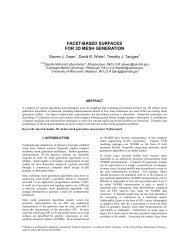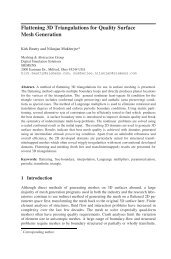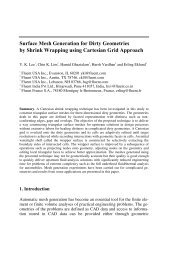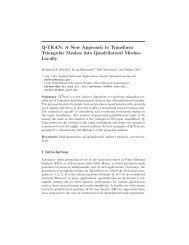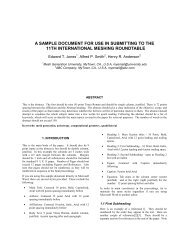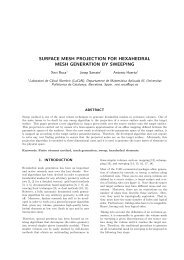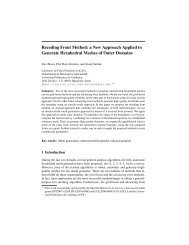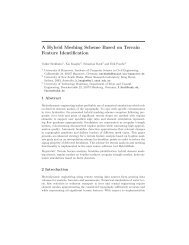Fitting Polynomial Surfaces to Triangular Meshes with Voronoi ...
Fitting Polynomial Surfaces to Triangular Meshes with Voronoi ...
Fitting Polynomial Surfaces to Triangular Meshes with Voronoi ...
Create successful ePaper yourself
Turn your PDF publications into a flip-book with our unique Google optimized e-Paper software.
<strong>Fitting</strong> <strong>Polynomial</strong> <strong>Surfaces</strong> <strong>to</strong> <strong>Triangular</strong> <strong>Meshes</strong><br />
<strong>with</strong> <strong>Voronoi</strong> Squared Distance Minimization<br />
Vincent Nivoliers 1,2 , Dong-Ming Yan 1,3 , and Bruno Lévy 1<br />
1 Project ALICE / Institut National de Recherche en Informatique et en<br />
Au<strong>to</strong>matique (INRIA) Nancy Grand Est, LORIA<br />
2 Institut National Polytechnique de Lorraine (INPL)<br />
3 Geometric Modeling and Scientific Visualization Center, King Abdullah<br />
University of Science and Technology (KAUST)<br />
Vincent.Nivoliers@loria.fr, Dongming.Yan@inria.fr,<br />
Bruno.Levy@inria.fr<br />
This paper introduces <strong>Voronoi</strong> Squared Distance Minimization (VSDM), an<br />
algorithm that fits a surface <strong>to</strong> an input mesh. VSDM minimizes an objective<br />
function that corresponds <strong>to</strong> a <strong>Voronoi</strong>-based approximation of the overall<br />
squared distance function between the surface and the input mesh (SDM).<br />
This objective function is a generalization of Centroidal <strong>Voronoi</strong> Tesselation<br />
(CVT), and can be minimized by a quasi-New<strong>to</strong>n solver. VSDM naturally<br />
adapts the orientation of the mesh <strong>to</strong> best approximate the input, <strong>with</strong>out<br />
estimating any differential quantities. Therefore it can be applied <strong>to</strong> triangle<br />
soups or surfaces <strong>with</strong> degenerate triangles, <strong>to</strong>pological noise and sharp features.<br />
Applications of fitting quad meshes and polynomial surfaces <strong>to</strong> input<br />
triangular meshes are demonstrated.<br />
1 Introduction<br />
We focus on the problem of fitting a surface S <strong>to</strong> an input mesh T , under the<br />
following assumptions :<br />
• An initial template S (0) is available. For instance, if T is a <strong>to</strong>pological<br />
sphere, S (0) can be initialized as the bounding box of T (see Figure 1-<br />
center). For higher genus, some existing au<strong>to</strong>matic or interactive methods<br />
may be used <strong>to</strong> construct the template S (0) (see Section 4);<br />
• the reconstructed surface S can be a polygon mesh or a polynomial surface;
2 Vincent Nivoliers, Dong-Ming Yan, and Bruno Lévy<br />
Fig. 1: Given an input mesh T (<strong>to</strong>p, 2065 vertices and 4114 facets) and a control<br />
mesh (898 vertices and 896 quads) in an initial position (center), VSDM minimizes<br />
the squared distance between T and the polynomial surface S defined by the control<br />
mesh. The Hausdorff distance between the result (bot<strong>to</strong>m) and the input mesh (<strong>to</strong>p)<br />
is 0.554% of the bounding box diagonal. Other views of the same data are shown<br />
further in the paper.<br />
• the input mesh T may have degenerate triangles and/or <strong>to</strong>pological degeneracies<br />
such as T-junctions, holes or <strong>to</strong>pological noise.<br />
We introduce VSDM (<strong>Voronoi</strong> Squared Distance Minimization), an algorithm<br />
that fits the template S <strong>to</strong> the input mesh T by minimizing an objective function<br />
˜F of the set of coordinates that determines S, i.e. the vertices of a polygon<br />
mesh or the control points of a polynomial surface. Figure 1 shows an example<br />
of fitting a polynomial surface <strong>to</strong> an input triangulated mesh.<br />
This paper makes the following contributions :<br />
• definition of ˜F (Section 3.1), and proof that it converges <strong>to</strong> the integrated<br />
squared distance (Appendix A);<br />
• solution mechanism <strong>to</strong> minimize ˜F (Sections 3.3, 3.4);<br />
• some applications <strong>to</strong> quad mesh fitting and polynomial surface fitting<br />
(Section 3.5).
<strong>Voronoi</strong> Squared Distance Minimization 3<br />
advantages:<br />
1. VSDM can fit a surface S <strong>to</strong> an input mesh T even if the initialization<br />
S (0) is far away from T (typically a bounding box);<br />
2. unlike methods based on parameterization, VSDM can process meshes<br />
<strong>with</strong> sharp angles and skinny triangles;<br />
3. VSDM adapts the orientation of the control mesh in a way that best approximates<br />
the input surface, <strong>with</strong>out requiring computation of its curvature<br />
tensor.<br />
limitations/uncovered aspects:<br />
1. VSDM may generate pinchouts or overlaps, for instance when trying <strong>to</strong><br />
fit a simple template S (0) <strong>to</strong> a surface that has long protrusions / high<br />
Gaussian curvature. This can be fixed in most cases by designing a better<br />
template S (0) ;<br />
2. we do not prove the C 2 continuity of the objective function. However,<br />
in our empirical studies, the numerical optimization behaves well (see<br />
discussion in Section 3.4) ;<br />
3. Dynamically modifying the <strong>to</strong>pology of S is not adressed here. These<br />
<strong>to</strong>pics will be studied in future works.<br />
2 Background and previous work<br />
Methods based on parameterization<br />
<strong>Fitting</strong> splines was the motivation of early works in mesh parameterization<br />
for objects homeomorphic <strong>to</strong> a disc [8]. For fitting splines <strong>to</strong> objects of arbitrary<br />
genus, it is possible <strong>to</strong> use a parameterization defined over a base<br />
complex [7, 20], polycube maps [21, 22] or global parameterization methods<br />
[19, 12]. The relations between the curvature of the surface and the metric<br />
defined by the parameterization is studied in [10] and used <strong>to</strong> compute an<br />
anisotropic mesh that minimizes the approximation error. Since they require<br />
the estimates of differential quantities (gradients, curvature, shape opera<strong>to</strong>r<br />
. . . ), the methods above cannot be applied <strong>to</strong> meshes <strong>with</strong> degeneracies<br />
(skinny triangles, multiple components, holes, sharp creases). Our methods<br />
that directly minimizes the squared distance does not suffer from this limitation.
4 Vincent Nivoliers, Dong-Ming Yan, and Bruno Lévy<br />
Methods based on point-<strong>to</strong>-point distances<br />
To remesh surfaces, “shrink-wrap” methods [5, 9] iteratively project the template<br />
on<strong>to</strong> the input mesh while minimizing a regularization criterion. A<br />
similar idea can be applied <strong>to</strong> subdivision surfaces [15, 16], using an exact<br />
algorithm <strong>to</strong> find closest points on the subdivision surface and the exact evaluation<br />
of the subdivision surface. The “dual domain relaxation” method [25]<br />
uses some variants of Laplace surface editing <strong>to</strong> fit a template <strong>to</strong> the input<br />
mesh. Since they are based on point-<strong>to</strong>-point distances, the methods above<br />
can mostly do small corrections on the geometry, and have difficulties converging<br />
when the initialization is far away from the target surface. In contrast,<br />
VSDM can successfully fit a control mesh <strong>to</strong> a surface.<br />
Squared distance minimization (SDM)<br />
SDM was proposed by Pottmann et al. [18] for curve and surface fitting. The<br />
SDM framework fits a surface S <strong>to</strong> an input mesh T by minimizing an approximation<br />
of the objective function E(X) :<br />
E(X) = F S→T (X) + λR(X)<br />
where:<br />
F S→T (X) = ∫ S(X) ‖ x − Π T (x) ‖ 2 dx<br />
R(X) = ‖LX‖ 2 (1)<br />
In this equation, X = [x i ]<br />
i=0 n denotes the coordinates that determine S and<br />
Π T (x) denotes the projection of x on<strong>to</strong> T , i.e. the point of T nearest <strong>to</strong> x. The<br />
term R(X) is a quadratic regularization energy and L a discretization of the<br />
Laplacian. The regularization fac<strong>to</strong>r λ lets the user choose a tradeoff between<br />
the smoothness of S and the fitting criterion.<br />
Wang et al. [23] showed that SDM can be characterized as a quasi-New<strong>to</strong>n<br />
method and they applied it <strong>to</strong> B-spline curve fitting. Cheng et al. [2, 3] proposed<br />
a subdivision surface fitting algorithm based on SDM. In the methods<br />
above, the approximation of the integral is based on both a point-sampling<br />
X = [x i ]<br />
i=1 n of S and a point-sampling Y = [y j] m j=0<br />
of T . The approximation<br />
has several variants that correspond <strong>to</strong> Taylor expansions of different orders<br />
(see Figure 2).<br />
The squared distance between x i and T can be replaced by :<br />
• Point Distance (PD): the squared distance <strong>to</strong> the nearest sample y j (order<br />
0 approximation);<br />
• Tangent Distance (TD): the squared distance <strong>to</strong> the nearest point on the<br />
tangent plane of the nearest sample (order 1 approximation);
<strong>Voronoi</strong> Squared Distance Minimization 5<br />
Fig. 2: Illustration of different approximations of SDM. The dashed lines represent<br />
iso lines of the distance function <strong>to</strong> the sample<br />
• Squared Distance (SD): the order 2 approximation of the squared distance<br />
around y j .<br />
3 <strong>Voronoi</strong> Squared Distance Minimization<br />
SDM requires an accurate estimation of the curvature tensor on T , which<br />
may be not available if T is a triangle soup or a CAD mesh <strong>with</strong> many skinny<br />
triangles. Therefore, <strong>to</strong> allow processing such degenerate input meshes, VSDM<br />
directly uses the local geometry of T around y j by integrating the squared<br />
distance function over a small patch (a restricted <strong>Voronoi</strong> cell), as explained<br />
in the next subsection.<br />
In addition, we note that F S→T vanishes whenever S matches a subset of<br />
T (instead of the <strong>to</strong>tality of T ). Therefore, <strong>to</strong> avoid degenerate minimizers<br />
that partially match T , we propose <strong>to</strong> minimize a symmetrized version of<br />
SDM given by F S→T + F T →S . The benefit of the symmetrized formulation is<br />
demonstrated later (subsection 3.3).<br />
3.1 Definition<br />
VSDM minimizes an approximation of the following objective function :<br />
F(X) = F T →S (X) + F S→T (X) + λR(X) (2)<br />
Let us consider the first term F T →S . Using a sampling X of S, we make the<br />
following approximation ‖y − Π S (y)‖ ≃ min i ‖y − x i ‖. Replacing the integrand<br />
of F T →S gives :
6 Vincent Nivoliers, Dong-Ming Yan, and Bruno Lévy<br />
F T →S = ∫ T ‖y − Π S(y)‖ 2 dy<br />
≃ ∫ T min i ‖y − x i ‖ 2 dy<br />
= ∑ i<br />
∫Ω i ∩T ‖y − x i‖ 2 dy<br />
where Ω i denotes the 3D <strong>Voronoi</strong> cell of x i . We shall now give the definition<br />
of the approximation ˜F of F minimized by VSDM :<br />
˜F(X)<br />
where :<br />
˜F T →S<br />
= ˜F T →S (X) + ˜F S→T (X) + λ X t L 2 X<br />
} {{ }<br />
R(X)<br />
= ∑<br />
x i ∈X<br />
˜F S→T = ∑<br />
y j ∈Y<br />
∫<br />
T ∩Ω i<br />
∫<br />
‖ y − x i ‖ 2 dy<br />
S∩Ω j<br />
‖ x − y j ‖ 2 dx<br />
(3)<br />
The matrix L is the uniform graph Laplacian of S. The influence of the regularization<br />
fac<strong>to</strong>r λ is illustrated in Figure 3. Ω i denotes the <strong>Voronoi</strong> cell of<br />
x i in the <strong>Voronoi</strong> diagram of X, and Ω j the <strong>Voronoi</strong> cell of y j in the <strong>Voronoi</strong><br />
diagram of Y (see Figure 4).<br />
3.2 Convergence <strong>to</strong> the continuous objective function<br />
The VSDM approximation replaces the nearest point on S <strong>with</strong> the nearest<br />
sample of X (in the term F T →S ) and the nearest point on T <strong>with</strong> the nearest<br />
sample of Y (in the term F S→T ). The accuracy of the approximation depends<br />
Fig. 3: Influence of the regularization fac<strong>to</strong>r λ on subdivision surface fitting.
<strong>Voronoi</strong> Squared Distance Minimization 7<br />
(a) ˜F T →S<br />
(b) ˜F S→T<br />
Fig. 4: Illustration of the terms of the VSDM objective function. The shaded regions<br />
represent for each sample x i (resp. y j ) the portion T ∩ Ω i (resp. S ∩ Ω j ) of the other<br />
surface whose squared distance <strong>with</strong> respect <strong>to</strong> the sample is integrated.<br />
on the density of the point sets X and Y used <strong>to</strong> sample S and T respectively.<br />
The density of a sampling is formalized by the notion of ε-sampling [1]. A<br />
point set X is an ε-sampling of a surface S if for any point x of S there is<br />
a point x i in X such that ‖x i − x‖ < ε lfs(x) where lfs(x) denotes local feature<br />
size (distance <strong>to</strong> medial axis of S). ˜F T →S satisfies the following property<br />
(proved in Appendix A).<br />
Property 1. Given X, an ε-sampling of S, we have :<br />
lim ˜F T →S (X) = F T →S (X)<br />
ε→0<br />
The same property is satisfied by the symmetric term ˜F S→T if Y is an ε-<br />
sampling of T . Therefore, if X and Y are dense enough, ˜F is a good approximation<br />
of F. Note that ε-sampling is not defined for non-smooth surfaces. In<br />
all our experiments, we <strong>to</strong>ok X as the vertices of S and Y as a sampling of T<br />
<strong>with</strong> the same number of vertices as X, optimized by CVT [24].<br />
3.3 Need for the symmetrized objective function<br />
The term ˜F T →S of ˜F corresponds <strong>to</strong> the objective function minimized by<br />
Restricted CVT. Therefore, omitting the term ˜F S→T results in the objective<br />
function ˜F T →S + λR(X), that can be minimized by a straightforward modification<br />
of the CVT quasi-New<strong>to</strong>n algorithm used in [14, 24], i.e. by adding<br />
the term λX t L 2 X <strong>to</strong> the objective function and 2λL 2 X <strong>to</strong> the gradient. However,<br />
as noted before, the function F T →S reaches a minimum whenever S is<br />
a superset of T . Therefore, a minimizer of F T →S may have spurious parts, as
8 Vincent Nivoliers, Dong-Ming Yan, and Bruno Lévy<br />
empty <strong>Voronoi</strong> cells<br />
Fig. 5: Top: the minimizer of ˜F T →S has spurious parts that cannot be eliminated<br />
since their <strong>Voronoi</strong> cells do not intersect the input mesh T . Bot<strong>to</strong>m: the symmetrized<br />
˜F = ˜F T →S + ˜F S→T detects and eliminates them.<br />
shown in Figure 5. These spurious parts correspond <strong>to</strong> the set S − Π S (T ),<br />
that does not yield any term in F T →S . In terms of the discretization ˜F S→T ,<br />
they correspond <strong>to</strong> <strong>Voronoi</strong> cells that have an empty intersection <strong>with</strong> T .<br />
3.4 Solution Mechanism<br />
To minimize the function ˜F = ˜F T →S + ˜F S→T + λR(X) in Equation 3, VSDM<br />
uses the L-BFGS algorithm [17, 13]. L-BFGS is a New<strong>to</strong>n-type algorithm, that<br />
uses successive evaluation of the function and its gradient <strong>to</strong> compute an<br />
approximation of the inverse of the Hessian. Although only the gradient is<br />
required in the computation, the objective function needs <strong>to</strong> be C 2 <strong>to</strong> ensure<br />
the proper convergence of the L-BFGS algorithms. We discuss here about the<br />
continuity of the three terms of ˜F :<br />
• The term R(X) is a quadratic form (C ∞ ) ;<br />
• the term ˜F T →S corresponds <strong>to</strong> the quantization noise power, which is the<br />
objective function minimized by a centroidal <strong>Voronoi</strong> tesselation. It is of<br />
class C 2 , except in some rarely encountered degenerate configurations<br />
(see [14] for a proof) ;<br />
• the term ˜F S→T is obtained by permuting the roles of the constant and<br />
variables in ˜F T →S . We will study its continuity in future work. Experimentally,<br />
it is regular enough for obtaining a stable behavior of L-BFGS.
<strong>Voronoi</strong> Squared Distance Minimization 9<br />
In practice, implementing L-BFGS requires <strong>to</strong> evaluate ˜F(X (k) ) and ∇ ˜F(X (k) )<br />
for a series of iterates X (k) (see Algorithm 1) :<br />
(1) X (0) ← vertices of S (0)<br />
(2) Y ← ε-sampling of T ; Compute Vor(Y)<br />
while minimum not reached do<br />
(3) Compute Vor(X (k) ), Vor(X (k) )| T and Vor(Y)| S<br />
(4) Compute ˜F T →S (X (k) ) and ∇ ˜F T →S (X (k) )<br />
(5) Compute R(X (k) ) and ∇R(X (k) )<br />
(6) Compute ˜F S→T (X (k) ) and ∇ ˜F S→T (X (k) )<br />
(7) Compute ˜F(X) and ∇ ˜F(X)<br />
(8) X (k+1) ← X (k) + p (k) ; Update S from X (k+1)<br />
end<br />
Algorithm 1: fitting a polygon mesh using VSDM.<br />
In order <strong>to</strong> make our work reproducible, we further detail each step :<br />
(2): the sampling Y of T , used by ˜F S→T , is computed by the CVT algorithm<br />
in [24], <strong>with</strong> the same number of vertices as in X ;<br />
(3): the Restricted <strong>Voronoi</strong> Diagrams Vor(Y)| S , Vor(X (k) )| T are computed as<br />
in [24] ;<br />
(4),(5): F T →S is the CVT objective function and R the regularization energy.<br />
The gradients are given by Equation 4 :<br />
∇| xi ˜F T →S = 2m i (x i − g i )<br />
∇R(X) = ∇X t L 2 X = 2L 2 X<br />
(4)<br />
where m i and g i denote the volume and the centroid of the restricted<br />
<strong>Voronoi</strong> cell Ω i ∩ T [6] ;<br />
(6): the term ˜F S→T is obtained by exchanging the roles of S and T in ˜F T →S<br />
and using the point set Y instead of X. The computation of this term and<br />
its gradient are explained in the next paragraph ;<br />
(8): p (k) denotes the step vec<strong>to</strong>r computed by L-BFGS.<br />
The function ˜F S→T depends on the <strong>Voronoi</strong> diagram of Y restricted <strong>to</strong> S (see<br />
Figure 6). Each restricted <strong>Voronoi</strong> cell Ω j ∩ S (colored polygons) is decomposed<br />
in<strong>to</strong> a set of triangles. One of them T = (c 1 , c 2 , c 3 ) is highlighted. Each<br />
triangle T of the decomposition of Ω j ∩ S contributes the following terms <strong>to</strong><br />
˜F S→T and ∇ ˜F S→T :<br />
˜F S→T T = |T|<br />
6<br />
∑ (c k − y j ) · (c l − y j ),<br />
1≤k≤l≤3<br />
d ˜F T S→T<br />
dX<br />
=<br />
3<br />
d ˜F<br />
S→T<br />
∑<br />
T dc<br />
k=1 k<br />
dc k<br />
dX (5)
10 Vincent Nivoliers, Dong-Ming Yan, and Bruno Lévy<br />
Fig. 6: Computing the gradient of the symmetric term ∇ ˜F S→T : configurations of<br />
the vertices of Vor(Y)| S .<br />
where dA/dB = (∂a i /∂b j ) i,j denotes the Jacobian matrix of A.<br />
The set of possible configurations for a vertex c k is similar <strong>to</strong> the combina<strong>to</strong>rial<br />
structure of the L p -CVT function [11], <strong>with</strong> the exception that the roles of<br />
the variables and constants are exchanged. Each configuration yields a Jacobian<br />
matrix that propagates the derivatives of ˜F T S→T from the c k’s <strong>to</strong> the x i ’s.<br />
There are 3 possible configurations (see overview in Figure 6) :<br />
→ c is a vertex x i of S (then dc/dx i = I 3×3 ) ;<br />
→ c has configuration (a) :<br />
c corresponds <strong>to</strong> the intersection between the bisec<strong>to</strong>r of [y 1 , y 2 ] (left,<br />
plane shown in blue) and an edge [x 1 , x 2 ] of S (right). The Jacobian matrices<br />
dc/dx 1 and dc/dx 2 are given in Appendix B, Equation 13;<br />
→ c has configuration (b) :<br />
c corresponds <strong>to</strong> the intersection between the three bisec<strong>to</strong>rs of [y 1 , y 2 ],<br />
[y 2 , y 3 ], [y 3 , y 1 ] (left) and a facet (x 1 , x 2 , x 3 ) of S (right). The Jacobian matrices<br />
dc/dx 1 , dc/dx 2 and dc/dx 3 are given in Appendix B, Equation 14.
3.5 <strong>Fitting</strong> <strong>Polynomial</strong> <strong>Surfaces</strong><br />
<strong>Voronoi</strong> Squared Distance Minimization 11<br />
We consider now the problem of fitting a polynomial surface defined by its<br />
control mesh C. At each iteration, we compute a polygonal approximation S<br />
of the polynomial surface. The vertices X of S are given as linear combinations<br />
of the control points P :<br />
X = MP<br />
where X = [x 1 y 1 z 1 . . . x n y n z n ] t denotes the coordinates at the vertices of S, P<br />
denotes the coordinates at the control points. One may use the exact evaluation<br />
of the polynomial surface, or simply use the approximation obtained by<br />
subdividing the control mesh several times <strong>with</strong> De Casteljau’s rule.<br />
<strong>Polynomial</strong> surface fitting is done by minimizing the function G(P) =<br />
˜F(MP). This can implemented <strong>with</strong> a change of variable in the VSDM algorithm<br />
(see Algorithm 2) :<br />
P (0) ← vertices of C (0)<br />
Y ← ε-sampling of T ; Compute Vor(Y)<br />
while minimum not reached do<br />
X ← MP (k) ; Update S from X<br />
Compute ˜F(X) and ∇ ˜F(X) as in Algo. 1, steps (3) <strong>to</strong> (7)<br />
Compute ∇G(P) = M t ∇ ˜F(X)<br />
P (k+1) ← P (k) + p (k)<br />
end<br />
Algorithm 2: <strong>Fitting</strong> a polynomial surface.<br />
3.6 Feature-Sensitive <strong>Fitting</strong><br />
Using the algorithm above for fitting polynomial surfaces may result in oversmoothing<br />
sharp creases (Figure 7 center). However, this can be improved by<br />
injecting normal anisotropy [11] in<strong>to</strong> the objective function ˜F (Figure 7 right).<br />
This changes the terms ˜F T →S and ˜F S→T as follows :<br />
˜F s T →S<br />
= ∑<br />
x i ∈X<br />
˜F<br />
S→T s = ∑<br />
y j ∈Y<br />
where :<br />
∫<br />
∑<br />
T⊂T ∩Ω i T<br />
∑<br />
T⊂S∩Ω j<br />
∫<br />
T<br />
‖ A s (N T )(y − x i ) ‖ 2 dy<br />
‖ A s (N j )(x − y j ) ‖ 2 dx<br />
(6)<br />
⎛<br />
N x [N] t ⎞<br />
A s (N) = (s − 1) ⎝N y [N] t ⎠ + I 3×3<br />
N z [N] t<br />
where the parameter s ∈ (0, +∞) specifies the importance of normal anisotropy.<br />
The normals are sampled from the input surface T in both terms, N T is the<br />
normal of the triangle T, and N j the normal <strong>to</strong> T at y j . Normal anisotropy is<br />
used in all the examples shown below.
12 Vincent Nivoliers, Dong-Ming Yan, and Bruno Lévy<br />
Fig. 7: Influence of the feature-sensitive fitting on meshes <strong>with</strong> sharp creases (from<br />
left <strong>to</strong> right: original mesh, result <strong>with</strong>out and <strong>with</strong> normal anisotropy).<br />
3.7 Implementation<br />
For the Delaunay triangulation, we use CGAL (www.cgal.org). For the Restricted<br />
<strong>Voronoi</strong> Diagram computation (Section 3.4) and the normal anisotropy<br />
(previous subsection), we use the implementation provided <strong>with</strong> [11].<br />
4 Results<br />
We shall now show some results obtained <strong>with</strong> VSDM. In the results herein,<br />
the regularization term is set <strong>to</strong> λ = 0.2 × 10 −3 , the normal anisotropy is<br />
set <strong>to</strong> s = 50 and subdivision surfaces are approximated by subdividing the<br />
control mesh twice. Figures 8, 9, and 10 show the result obtained <strong>with</strong> an<br />
initial <strong>to</strong>roidal grid. Note on Figure 12 how the spacing of the iso-parameter<br />
line adapts <strong>to</strong> the features. Scanned meshes from AimAtShape can also be<br />
efficiently processed (see Figure 13). For each model, the result was obtained<br />
in less than 3 minutes on a 2 GHz machine.<br />
Discussion and future work<br />
The examples shown in the previous section were obtained au<strong>to</strong>matically,<br />
by using the bounding box (or a <strong>to</strong>roidal mesh) as the initial control mesh.<br />
However, for shapes <strong>with</strong> an arbitrary genus or a complicated geometry, an<br />
initial control mesh is needed. Designing an initial control mesh may be also<br />
required <strong>to</strong> improve the quality of the surface. In future work, we will study<br />
the generation of an initial control mesh and/or the dynamic modification of<br />
the control mesh during the optimization.<br />
Acknowledgements<br />
The authors wish <strong>to</strong> thank Sylvain Lefebvre for a discussion (about an unrelated<br />
<strong>to</strong>pic) that inspired this work, Rhaleb Zayer, Xavier Goaoc, Tamy
<strong>Voronoi</strong> Squared Distance Minimization 13<br />
Fig. 8: <strong>Fitting</strong> a polynomial surface <strong>to</strong> an object <strong>with</strong> <strong>to</strong>roidal <strong>to</strong>pology. Left: input<br />
mesh (16.8k vertices, 33.6k facets); Center: initial control mesh (512 vertices and<br />
512 quads) and surface; Right: result. The Hausdorff distance between the resulting<br />
surface and the input mesh is 1.221% (relative <strong>to</strong> the diagonal length of the bounding<br />
box, measured by Metro [4]).<br />
Fig. 9: Another example, using the same initial <strong>to</strong>roidal control mesh as in Figure<br />
8. Left: input mesh (10k vertices, 20k facets); Center: result; Right: result (control<br />
mesh <strong>with</strong> 512 vertices and 512 quads). Hausdorff distance is 0.473% bbox. diag.<br />
Fig. 10: Another example, still using the same initial <strong>to</strong>roidal control mesh. Left:<br />
input mesh (5.2k vertices and 10.4k facets); Center: result; Right: result (control<br />
mesh <strong>with</strong> 512 vertices and 512 quads). The Hausdorff distance is 0.699% bbox.<br />
diag.
14 Vincent Nivoliers, Dong-Ming Yan, and Bruno Lévy<br />
Fig. 11: Other examples <strong>with</strong> geometrical shapes. Initialization from bounding box<br />
(386 vertices and 384 quads). Left: input mesh of sharp sphere (10.4k vertices, 20.9k<br />
facets) and result. Right: input mesh of octa-flower (7.9k vertics and 15.8k facets)<br />
and result. Hausdorff distances are 1.072% and 0.706% bbox. diag., respectively.<br />
Fig. 12: Different views of the example shown in Figure 1. The Hausdorff distance<br />
between the input and result is 0.554% of the bounding box diagonal.<br />
Boubekeur, Yang Liu and Wenping Wang for many discussions, Loic Marechal,<br />
Marc Loriot and the AimAtShape reposi<strong>to</strong>ry for data. This project is partly<br />
supported by the European Research Council grant GOODSHAPE ERC-StG-<br />
205693 and ANR/NSFC (60625202,60911130368) Program (SHAN Project).
<strong>Voronoi</strong> Squared Distance Minimization 15<br />
Fig. 13: <strong>Fitting</strong> a Catmull-Clark subdivision surface <strong>to</strong> the statue of Max Planck<br />
(52.8k vertices and 105.6 facets). Initialization from bounding box (6257 vertices<br />
and 6255 quads). The Hausdorff distance is 0.386% of the bounding box diagonal.<br />
A Convergence <strong>to</strong> squared distance - Error bound<br />
The following section proves that if X is an ε-sampling of S then:<br />
lim ˜F T →S (X) = F T →S (X) (7)<br />
ε→0<br />
Lemma 1. Let y be a point of T and x i its nearest point in X (see Figure 14). Let<br />
d =‖ y − Π S (y) ‖ and d ˜ =‖ y − x i ‖. Then for ε < 2 the following bound is<br />
sharp:<br />
d˜<br />
2 − d 2 ≤ ε 2 lfs(Π S (y))(lfs(Π S (y)) + d)<br />
Proof. Let B Vor be the ball centered at y passing through x i . This ball contains<br />
no point of X.<br />
Let B l f s be the ball tangent <strong>to</strong> S at Π S (y) on the opposite side of y and of<br />
radius lfs(Π S (y)) and c l f s its center. Since X is an ε-sampling this ball also<br />
contains no point of X.<br />
Finally let B ε be the ball centered at Π S (y) of radius εlfs(Π S (y)). Since X is<br />
an ε sampling this ball contains no point of S, and therefore no point of X.<br />
Since Π S (y) is the nearest point of y on S, y, Π S (y) and c l f s are aligned and<br />
the problem is completely symmetric around the line joining them. Figure 14<br />
shows a cut containing this axis.
16 Vincent Nivoliers, Dong-Ming Yan, and Bruno Lévy<br />
Fig. 14: Configuration of the nearest point of Π S (y).<br />
The bound follows from the fact that B ε ̸⊂ B Vor ∪ B l f s . Let p be a point of<br />
B Vor ∩ B l f s . This point exists since ε < 2 and B ε is not included in B Vor .<br />
Using this point the previous condition can be reformulated as p ∈ B ε .<br />
Using triangular identities in (Π S (y), c l f s , p), we have:<br />
‖ Π S (y) − p ‖ 2 = 2lfs(Π S (y)) 2 (1 − cos α) (8)<br />
<strong>with</strong> α being the (p, c l f s , Π S (y)) angle. Using the same identities in (x, c l f s , p)<br />
we obtain:<br />
˜ d 2 = (d + lfs(Π S (y))) 2 + lfs(Π S (y)) 2<br />
− 2(d + lfs(Π S (y)))lfs(Π S (y)) cos α<br />
d˜<br />
2 − d 2 = 2(d + lfs(Π S (y)))lfs(Π S (y))(1 − cos α)<br />
Using equation 8, (1 − cos α) can be replaced:<br />
d˜<br />
2 − d 2 = (d + lfs(Π S (y))) ‖ Π S(y) − p ‖ 2<br />
lfs(Π S (y))<br />
(9)<br />
Finally since p is inside B ε , we have:<br />
This finally provides the result:<br />
‖ Π S (y) − p ‖≤ εlfs(Π S (y)) (10)<br />
˜ d 2 − d 2 ≤ ε 2 lfs(Π S (y))(lfs(Π S (y)) + d) (11)<br />
This bound is sharp since it is reached whenever S is exactly B l f s and x i is<br />
located at p.
This lemma leads <strong>to</strong> a global bound:<br />
<strong>Voronoi</strong> Squared Distance Minimization 17<br />
Proposition 1. If S is different from a plane and bounded, then:<br />
˜F T →S (X) − F T →S (X) ≤ ε 2 |T |σ S (σ S + d H (T , S))<br />
where σ S = sup{lfs(x), x ∈ S}<br />
Proof. Since S is not a plane and bounded, σ exists. In addition, the definition<br />
of the Hausdorff distance gives us d ≤ d H (T , S).<br />
e = ˜F T →S (X) − F T →S (X)<br />
∫<br />
∫<br />
= min ‖ y − x i ‖ 2 dy − ‖ y − Π S(y) ‖ 2 dy<br />
T i<br />
T<br />
∫<br />
= min ‖ y − x i ‖ 2 − ‖ y − Π S (y) ‖ 2 dy<br />
T i<br />
∫<br />
≤<br />
T ε2 σ S (σ S + d H (T , S))dy<br />
≤ ε 2 |T |σ S (σ S + d H (T , S)) (12)<br />
B Gradients of the symmetric term ∇ ˜F S→T<br />
⎧<br />
Configuration (a) :<br />
dc<br />
dx 1<br />
= ew t 1 + (1 − u)I 3×3<br />
dc<br />
dx 2<br />
= ew t 2 + uI 3×3<br />
⎪⎨<br />
where :<br />
e = (x 2 − x 1 )<br />
n = (y 2 − y 1 )<br />
k = n · e<br />
h = 1 2 n · (y 1 + y 2 )<br />
u = 1 k (h − n · x 1)<br />
w 1 = − 1 (h − n · x<br />
k ⎪⎩<br />
2 2 )n<br />
w 2 = 1 (h − n · x<br />
k 2 1 )n<br />
(13)<br />
Configuration (b) :<br />
dc<br />
dx 1<br />
= ew t 1<br />
dc<br />
dx 2<br />
= ew t 2<br />
dc<br />
dx 3<br />
= ew t 3<br />
⎧<br />
e = (y 1 − y 2 ) × (y 1 − y 3 )<br />
n = (x ⎪⎨<br />
1 − x 2 ) × (x 1 − x 3 )<br />
k = n · e<br />
where :<br />
w 1 = ((x 2 − x 3 ) × (x 1 − c) + n)/k<br />
w ⎪⎩ 2 = ((x 3 − x 1 ) × (x 1 − c))/k<br />
w 3 = ((x 1 − x 2 ) × (x 1 − c))/k<br />
(14)<br />
References<br />
1. N. Amenta and M. Bern. Surface reconstruction by <strong>Voronoi</strong> filtering. Discrete and<br />
Computational Geometry, 22(4):481–504, 1999.
18 Vincent Nivoliers, Dong-Ming Yan, and Bruno Lévy<br />
2. K.-S. D. Cheng, W. Wang, H. Qin, K.-Y. K. Wong, H.-P. Yang, and Y. Liu. <strong>Fitting</strong><br />
subdivision surfaces using SDM. In Pacific Graphics conf. proc., pages 16–24, 2004.<br />
3. K.-S.D. Cheng, W. Wang, H. Qin, K.-Y.K. Wong, H.-P. Yang, and Y. Liu. Design<br />
and analysis of methods for subdivision surface fitting. IEEE TVCG, 13(5), 2007.<br />
4. P. Cignoni, C. Rocchini, and R. Scopigno. Metro: measuring error on simplified<br />
surfaces. Comp. Graphics Forum, 17(2):167–174, 1998.<br />
5. H. Delingette. General object reconstruction based on simplex meshes. IJCV,<br />
32(2):111–146, 1999.<br />
6. Q. Du, V. Faber, and M. Gunzburger. Centroidal <strong>Voronoi</strong> tessellations: applications<br />
and algorithms. SIAM Review, 41(4):637–676, 1999.<br />
7. M. Eck and H. Hoppe. Au<strong>to</strong>matic reconstruction of B-spline surfaces of arbitrary<br />
<strong>to</strong>pological type. In Proc. ACM SIGGRAPH, pages 325–334, 1996.<br />
8. M.S. Floater. Parametrization and smooth approximation of surface triangulations.<br />
Computer Aided Geometric Design, 14(3):231–250, 1997.<br />
9. L. Kobbelt, J. Vorsatz, U. Labsik, and H.-P. Seidel. A shrink wrapping approach<br />
<strong>to</strong> remeshing polygonal surfaces. Comp. Graphics Forum, 18(3), 2001.<br />
10. D. Kovacs, A. Myles, and D. Zorin. Anisotropic quadrangulation. In Proceedings<br />
of the 14th ACM Symposium on Solid and Physical Modeling, pages 137–146, 2010.<br />
11. B. Lévy and Y. Liu. L p centroidal <strong>Voronoi</strong> tessellation and its applications. ACM<br />
TOG (Proc. SIGGRAPH), 29(4):Article No. 119, 2010.<br />
12. W.-C. Li, N. Ray, and B. Lévy. Au<strong>to</strong>matic and interactive mesh <strong>to</strong> T-spline conversion.<br />
In Symposium on Geometry Processing, pages 191–200, 2006.<br />
13. D.C. Liu and J. Nocedal. On the limited memory BFGS method for large scale<br />
optimization. Mathematical Programming: Series A and B, 45(3):503–528, 1989.<br />
14. Y. Liu, W. Wang, B. Lévy, F. Sun, D.-M. Yan, L. Lu, and C. Yang. On centroidal<br />
<strong>Voronoi</strong> tessellation — energy smoothness and fast computation. ACM Trans. on<br />
Graphics, 28(4):Article No. 101, 2009.<br />
15. W. Ma, X. Ma, S.-K. Tso, and Z. Pan. A direct approach for subdivision surface<br />
fitting. Comp. Aided Design, 36(6), 2004.<br />
16. M. Marinov and L. Kobbelt. Optimization methods for scattered data approximation<br />
<strong>with</strong> subdivision surfaces. Graphical Models, 67(5):452–473, 2005.<br />
17. J. Nocedal and S.J. Wright. Numerical Optimization. Springer, 2006.<br />
18. H. Pottmann and S. Leopoldseder. A concept for parametric surface fitting which<br />
avoids the parametrization problem. Comp. Aided Geom. Design, 20(6), 2003.<br />
19. N. Ray, W.C. Li, B. Lévy, A. Scheffer, and P. Alliez. Periodic global parameterization.<br />
ACM Trans. on Graphics, 25(4):1460–1485, 2006.<br />
20. J. Schreiner, A. Asirvatham, E. Praun, and H. Hoppe. Inter-surface mapping.<br />
ACM TOG (Proc. SIGGRAPH), 23(3):870–877, 2004.<br />
21. M. Tarini, K. Hormann, P. Cignoni, and C. Montani. Polycube-maps. ACM TOG<br />
(Proc. SIGGRAPH), 23(3):853–860, 2004.<br />
22. H. Wang, Y. He, X. Li, X. Gu, and H. Qin. Polycube splines. Comp. Aided Design,<br />
40(6):721–733, 2008.<br />
23. W. Wang, H. Pottmann, and Y. Liu. <strong>Fitting</strong> B-spline curves <strong>to</strong> point clouds by<br />
curvature-based sdm. ACM Trans. on Graphics, 25(2):214–238, 2006.<br />
24. D.-M. Yan, B. Lévy, Y. Liu, F. Sun, and W. Wang. Isotropic remeshing <strong>with</strong> fast and<br />
exact computation of restricted <strong>Voronoi</strong> diagram. Comp. Graphics Forum (Proc.<br />
SGP), 28(5):1445–1454, 2009.<br />
25. I-C. Yeh, C.-H. Lin, O. Sorkine, and T.-Y. Lee. Template-based 3D model fitting<br />
using dual-domain relaxation. IEEE TVCG, 17(8):1178–1190, 2011.




